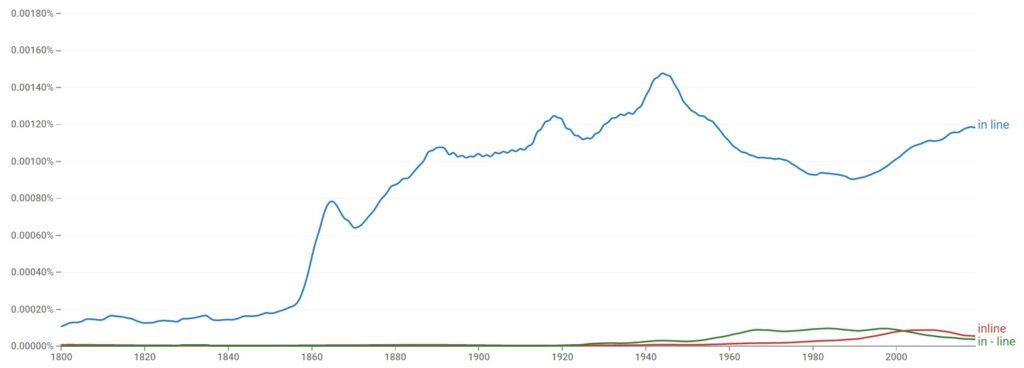If you want to show that something is “in line,” it will help a great deal to make sure your grammar is in line. This article will help you understand whether it’s one or two words. We can also show you when the hyphenated form might work.
In line vs. In-line vs. Inline
“In line” is correct when written as two words. It is considered a phrase when we use it in this way, which means it usually sets up more information in a sentence. “In-line” can be hyphenated when it’s an adjective, but “inline” is never grammatically correct.

According to Google Ngram Viewer, “in line” is the most popular choice. There is a huge difference between the three variations, and “in line” is the clear winner of the lot.

The graph makes it seem like “in-line” is just as popular as “inline,” which shows that the adjective form isn’t all that common. However, it is still correct, and it would help to learn more about it.
The Cambridge Dictionary and The Oxford Dictionary both prove that “in-line” is correct. While both dictionaries provide entries for “in line” as a two-word phrase, they also provide similar entries for “in-line” when it is used as an adjective.
It might help to refer to these examples if you’re stuck about the differences with nouns and adjectives;
- Adjective: I’m going to get the in-line version of this product.
- Noun: You’re not in line with the rest of them, and you need to figure that out!
Is “Inline” One Word?
“Inline” is incorrect. There is never a case where it makes sense to group the two words into one. Sometimes, we might drop a hyphen in favor of a one-word variation, but this does not apply when we are referring to the adjective form of “in-line.”
These examples will help you understand more about it:
- Correct: If you’re not going to keep your children in line, then I really don’t see why you bothered to bring them.
- Incorrect: I can’t keep them inline, and I’m at a loss for what else I can do to fix that!
- Correct: I’ll have the in-line cylinder engine in my car by the end of the week. It’ll be so much better.
- Incorrect: Have you figured out how to play around with the inline code yet?
Is “In line” Two Words?
“In line” is most commonly written as two words. This makes sense when we use it as a phrase to show that we want someone or something under our control. We do not group the words because “in” is a preposition that comes up alongside the noun “line.”
Check these examples out if you need a little extra help with it:
- I’m not going to find a way to keep them in line. I don’t think they would listen to me anyway.
- You’ll have to try harder to get them in line. Sorry, but that’s just the way it is.
- I’ll get them in line somehow. Just wait and see. I know what I’m doing.
- I thought it would be better to keep them this way so that they’re in line. I can see that I was wrong, though.
Is “In-line” Hyphenated?
“In-line” can be hyphenated when it is an adjective. However, it is not a particularly common adjective form, so it’s not something that you’ll have to worry too much about using. Nevertheless, it’s standard practice in English to group multiple words when they become adjectives.
AP Style rules are the rules we’re referring to. We can use AP Style to hyphenate more than one word when all of the words modify the same noun in some way.
Here are some examples that should make it more clear:
- You’ll have to find a few more in-line functions if you’re going to solve this issue.
- I’ll have a look at the latest in-line engine parts to see which is best for me.
- In-line products are the way forward. Just wait and see what looks best for you.
- I’ll keep everything with an in-line zeal, and I’ll make sure you don’t knock me off my perch.
Is “Line” Capitalized In The Word “In-Line”?
“In-line” only needs “in” to be capitalized. There is never a reason to also capitalize “line” since the hyphen treats them as the same word. If we write it in a title, we might find it useful to write “In-Line” to keep our form more professional.

Martin holds a Master’s degree in Finance and International Business. He has six years of experience in professional communication with clients, executives, and colleagues. Furthermore, he has teaching experience from Aarhus University. Martin has been featured as an expert in communication and teaching on Forbes and Shopify. Read more about Martin here.
